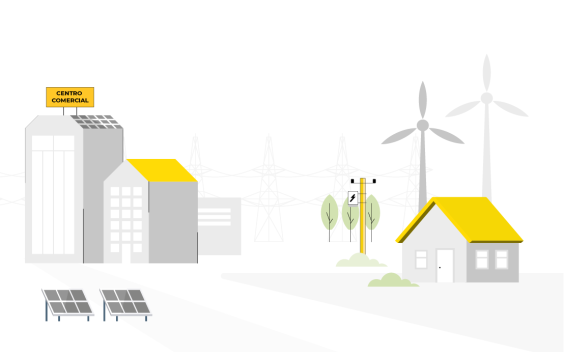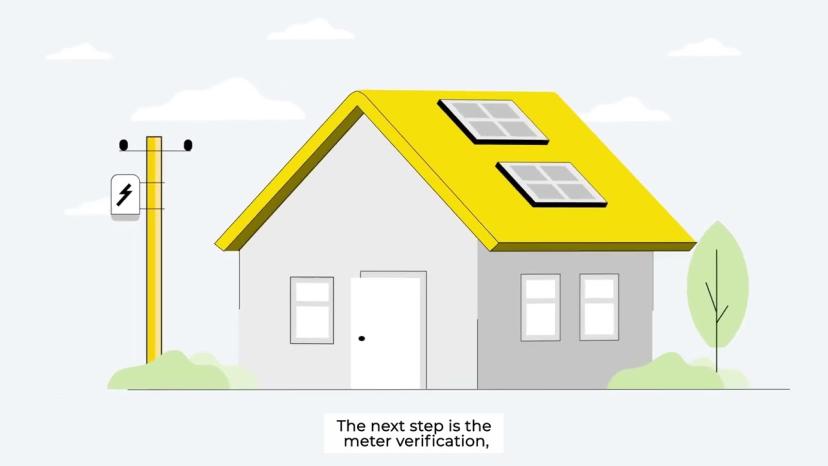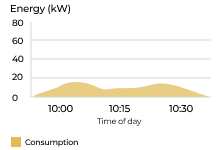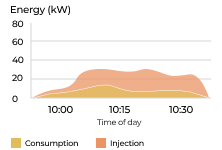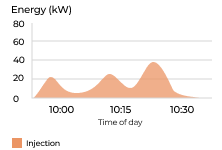Individual Self-Consumption
Renewable energy within everyone's reach.
Did you know that you can produce your own electricity sustainably and efficiently, contributing to a greener future? Individual self-consumption allows you to produce your electricity from renewable sources, use it for your own consumption and inject and/or sell the surplus into the grid. Find out how self-consumption works and how you can manage and monitor your energy injection.
I’m already a self-consumer
It's important to understand how to manage and monitor your historical meter readings and the consumption and energy you inject into the grid. To make sure you have all the information on the processes and challenges that may arise, we've put together all the information to help you on this page.
Digital Counter
The E-REDES Digital Counter will be your greatest ally. Here you can monitor your energy consumption and injection, ensuring that the system is working efficiently. You can also download Excel files to see detailed information about your readings and your consumption and injection figures.
1. After logging in, you will need to access the "Os meus locais" (“My locations”) option;

2. Then select "Leituras" (“Readings”);
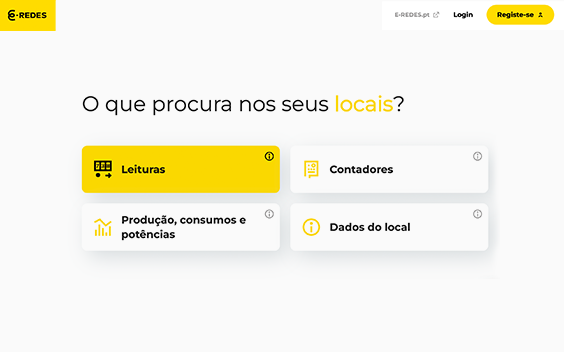
3. Then select "Consultar histórico" (View history);

4. Next, you must select the place of consumption you wish to consult;

5. You then access the Histórico de Leituras (or Readings History) where you can check your data for Energia Consumida (Consumed Energy) and Energia Injetada (Injected Energy):
- Consumed Energy - Low-Load/Peak/Normal;
- Consumed Energy - Low-Load/Peak/Normal Balance;
- Injected Energy - Low-Load/Peak/Normal;
- Injected Energy - Low-Load/Peak/Normal Balance.
To check the readings sent to your supplier, you should refer to the columns “Saldo” or “Balance”.
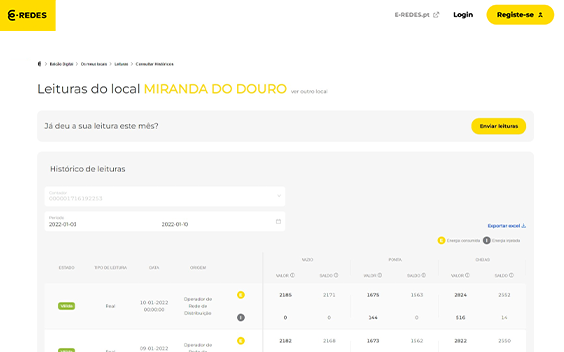
1. After logging in, you will need to access the "Os meus locais" (“My locations”) option;

2. Then select "Produção, consumos e potências", which translates to “Production, consumption, and power”;
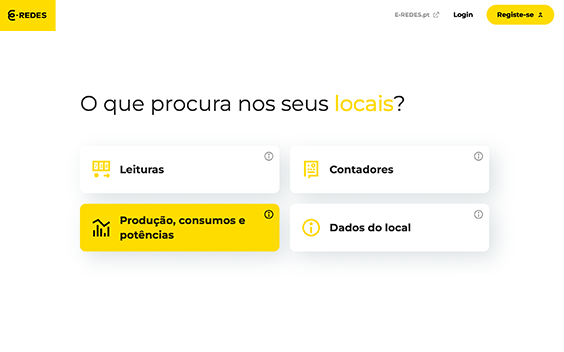
3. Then select "Consultar histórico" (View history);
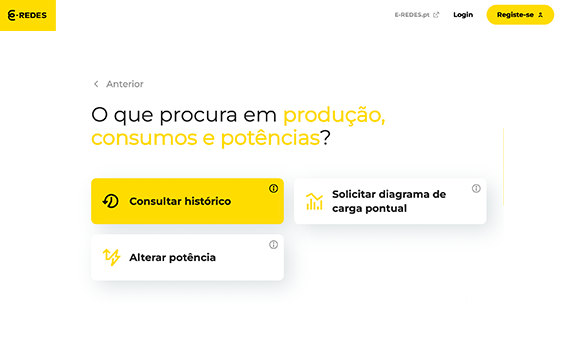
4. Next, you must select the place of consumption you wish to consult;

5. You then access the Diagrama de Cargas, which translates to Load Diagram, where you can visualise:
- Consumo registado (Registered consumption);
- Produção registada (Registered production);
- Consumo medido na IC (Consumption measured at the Consumption Facility);
- Injeção na rede medida na IC (Injection into the network measured at the Consumption Facility).
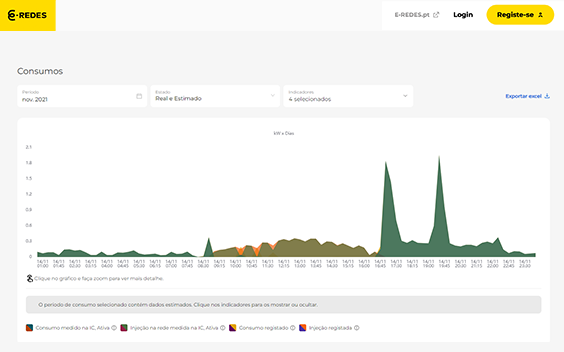
Clarify some questions related to your consumption
Measured Consumption at the Consumption Facility (CF) (kW): Accounts for the consumption recorded in a specific quarter-hour (15-minute period) after calculating the Quarter-Hourly Balance (SQH).
Injection into the Grid Measured at the CF, Active (kW): Accounts for the injection recorded in a specific quarter-hour after applying the SQH.
Registered Consumption (kW): Accounts for the total consumption recorded in a specific quarter-hour without applying the SQH.
Registered Injection (kW): Accounts for the total injection recorded in a specific quarter-hour without applying the SQH.
How do the reading values relate to the consumption/injection values? The total difference between the final and initial readings of "Low-Load/Peak/Normal Balance" for a specific period, obtained from the readings history extraction, should be equal (or approximately equal) to the sum of all the quarter-hourly values corresponding to "Measured Consumption at the CF (...)" multiplied by 0.25 (due to the conversion to kWh), as obtained from the load diagram for the period in question. These values may not always match perfectly because the consumption history presents data with three decimal places, while the values used in the reading history are presented to the nearest whole number.
In this scenario, the Consumption Facility consumes more energy than what is generated by the production facility (e.g., with photovoltaic panels). This means that part of the energy must be sourced from the electrical grid to cover the total consumption. There may also have been excess production relative to the energy needs, as there is an injection into the grid.
Example: The house consumed 35 kW from the Public Service Electricity Network (RESP) and injected 20 kW during the same period. In this case, applying the SQH (Quarter-Hourly Balance) can be summarized as subtracting the total injection from the total consumption from the grid, resulting in a surplus consumption of 15 kW to be billed to the customer.
Although there was an injection into the grid (20 kW), since this amount was entirely used to offset the consumption, the net injection balance will be zero.
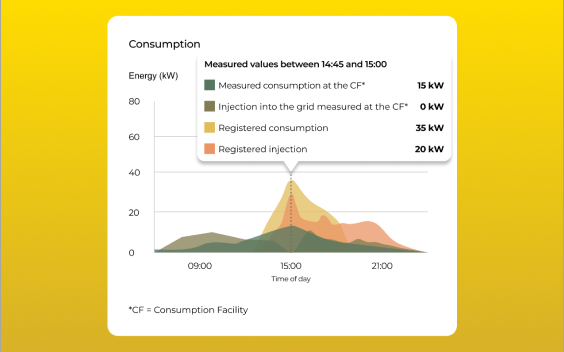
In this scenario, the production facility may or may not have generated energy, but any energy that was produced was entirely used by the CF. Since there was no injection into the grid, there will be nothing to offset against the energy consumed from the grid, so the results of the values before and after applying the SQH will be the same.
Example: During this period, two situations could have occurred: either the house consumed 25 kW and did not generate any energy with the Production Facility, so all 25 kW were sourced from the Public Network, or the energy produced by the Production Facility was exactly sufficient to cover the consumption of the CF.
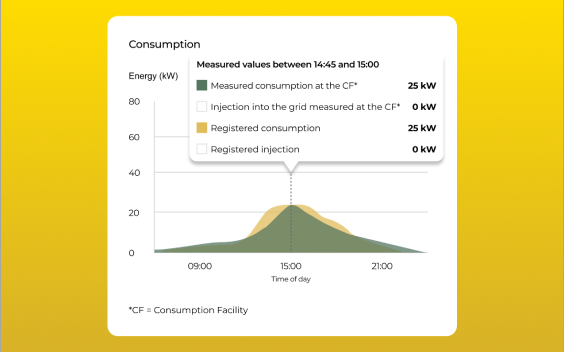
In this case, the energy generated by the panels exceeds the consumption of the CF, so the excess energy generated is injected back into the grid and can be sold to a supplier if an active surplus sale contract is in place.
Example: The house consumed 10 kW and, during the same period, injected 30 kW. By subtracting the total injection (30 kW) from the total consumption (10 kW), there is no consumption left to bill to the customer, as the result is negative (-20 kW), and consumption cannot be less than zero. The Consumption Balance will be zero, and the remaining 20 kW of injection corresponds to the Injection Balance, which can be sold as surplus if a sale contract is in place.
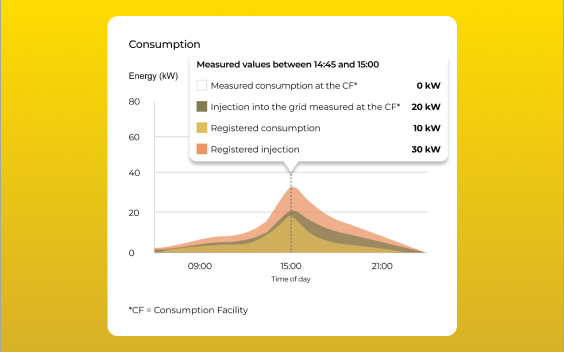
In this scenario, energy was produced with the Production Facility, but the Consumption Facility (CF) did not consume any energy from the grid during this period, only injecting energy into the grid. All the generated energy is injected into the electrical grid.
Example: The house consumed 0 kW from the grid and injected 30 kW during the same period. In this case, the Consumption Balance will remain at 0, and the Injection Balance will be equal to the gross value (30 kW), as there was no need to offset any consumption.

Understand how the consumption/injection calculations for your installation are made.

Find the answers to your questions on our frequently asked questions page.
